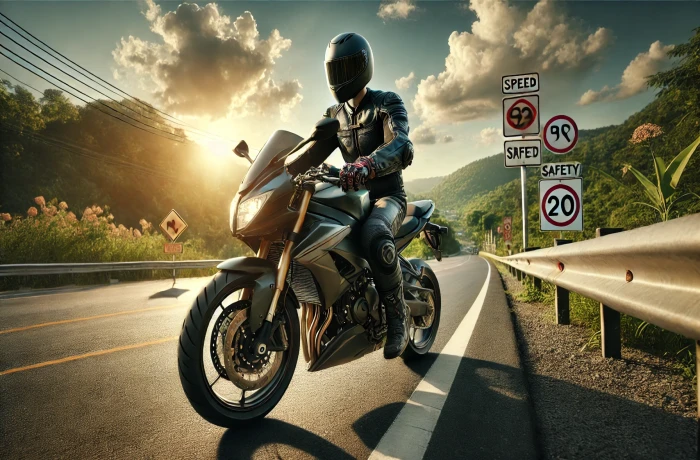Top Motorcycle Safety Tips to Keep You Protected on the Road

Lila Claybourne
Sep 23, 2024

The Importance of Motorcycle Safety
Riding a motorcycle offers an unparalleled sense of freedom and thrill. However, motorcycles come with inherent risks that are higher than those associated with cars and trucks. In fact, according to the National Highway Traffic Safety Administration (NHTSA), motorcyclists are 28 times more likely to die in a crash than car occupants. This alarming statistic underscores the importance of motorcycle safety. No matter your experience level, knowing and practicing essential safety measures is vital. By taking proactive steps and understanding the risks, riders can greatly reduce their chances of being involved in a fatal accident.
Importance of Wearing the Right Gear
One of the simplest yet most effective ways to ensure safety is by wearing the right protective gear. While no equipment can fully eliminate the risk of injury, high-quality protective gear can drastically reduce the severity of injuries in the event of an accident.
1. Helmets
A helmet is the most critical piece of safety gear. According to the NHTSA, wearing a helmet reduces the risk of head injury by 69% and the risk of death by 37%. Opt for helmets that meet DOT (Department of Transportation) standards, and consider helmets that also meet Snell Foundation certifications for enhanced safety.
Types of Helmets: Full-face helmets offer the best protection, covering your entire head and face. Modular helmets allow for flexibility in their design, while half-shell helmets provide less coverage but are popular for their lighter feel.
Helmet Care: Helmets should be replaced every five years, or after any impact, as their structural integrity could be compromised even if the damage isn’t visible.
2. Jackets and Pants
Motorcycle-specific jackets and pants are often designed with materials like leather or reinforced textile. These materials are durable and provide better abrasion resistance compared to regular clothing. Many riding jackets and pants come equipped with CE-rated armor at critical points like the shoulders, elbows, back, and knees.
Textile vs. Leather: Leather is traditionally known for its superior abrasion resistance, while modern textiles like Kevlar and Cordura offer great protection and are more versatile in different weather conditions.
Airbag Jackets: A relatively new innovation, airbag-equipped jackets inflate in the event of a crash to provide extra protection for the rider's chest, spine, and neck.
3. Gloves
Riding gloves not only protect your hands in a fall but also improve your grip and comfort while riding. The gloves should cover your wrists and offer padding in critical areas like the knuckles and palms.
Weather Considerations: Use insulated, waterproof gloves in cold or wet conditions to prevent numbness, which could affect your control of the bike.
4. Boots
Proper riding boots offer more than just comfort; they provide essential ankle support and protection against abrasions and crushing injuries. Choose boots that cover your ankles and have reinforced soles and toes.
Anti-Slip Soles: For wet conditions or off-road riding, ensure your boots have anti-slip soles to provide traction when you're stationary or pushing your bike.
5. Eye Protection
For those wearing open-face or half-helmets, eye protection is a must. Goggles or a strong visor will shield your eyes from dust, debris, insects, and the wind, all of which could impair your vision at critical moments.
6. Reflective Gear
At night or in low-light conditions, visibility becomes a significant issue for motorcyclists. Wearing reflective or brightly colored gear helps make you more visible to other drivers on the road.
Modern Motorcycle Safety Features
As motorcycles continue to evolve, manufacturers are integrating advanced safety technologies that help prevent accidents. These modern features are becoming increasingly common and can make a significant difference, especially for less experienced riders or those frequently riding in challenging conditions.
1. Anti-lock Braking System (ABS)
ABS prevents the wheels from locking up during sudden or hard braking, ensuring that the rider maintains control. This is particularly important in wet or slippery conditions, where traditional braking can lead to skidding. According to the Insurance Institute for Highway Safety (IIHS), motorcycles with ABS are 31% less likely to be involved in fatal crashes than those without it.
2. Traction Control
Traction control helps to prevent wheel spin, especially in situations where the road is wet or slick. By automatically adjusting the engine's power output, this system ensures that the tires maintain their grip, helping riders stay in control.
3. LED Lighting
LED headlights and taillights provide superior illumination compared to traditional bulbs, offering better visibility during nighttime or adverse weather conditions. The bright, clear light not only helps the rider see better but also ensures that other drivers can spot the motorcycle from a greater distance.
4. Stability Control and Ride Modes
Modern motorcycles, especially larger touring or sport models, often come with stability control systems and selectable ride modes. Stability control uses sensors to monitor the bike's lean angle and adjust power delivery accordingly, which is helpful during aggressive cornering. Ride modes allow riders to adjust the bike's performance (such as throttle response and traction control) based on road conditions.
5. Rearview Cameras and Blind Spot Detection
Some advanced models feature rearview cameras and blind spot monitoring systems that alert riders to nearby vehicles, reducing the risk of lane-changing collisions.
6. Onboard Diagnostics
Modern motorcycles come with onboard diagnostics that track everything from tire pressure to engine performance. These systems can alert riders to potential issues before they become dangerous.
Selecting the Right Motorcycle for Safety
Choosing a motorcycle that fits your experience level and physical capability is crucial for safe riding. Riders who select bikes that are too powerful or heavy for their skill level put themselves at a greater risk of accidents. Here's what to consider:
1. Engine Size and Power
For new riders, starting with a bike that has a smaller engine (under 600cc) is advisable. A smaller engine offers adequate power for most riding conditions while being more forgiving to beginner mistakes. As your skills improve, you can consider upgrading to a more powerful model.
Cruisers vs. Sport Bikes: Cruisers tend to have a lower center of gravity and more relaxed riding positions, which can be more comfortable for long rides. Sport bikes, while thrilling, have a more aggressive riding posture and higher performance, making them better suited for experienced riders.
2. Weight and Size
A motorcycle that’s too heavy for the rider can lead to difficulty in balance, especially at slower speeds or when stopping. It's essential to test different models to find one that feels manageable for your physical strength and riding style.
Seat Height: Ensure that your feet can comfortably touch the ground while seated. This helps in maintaining balance and control, especially in stop-and-go traffic.
3. Ergonomics
Comfort is a key factor in reducing fatigue and ensuring you maintain control over the bike. Consider the bike’s seat, handlebar position, and foot peg placement. Adjustments can often be made to improve comfort and fit, such as raising the handlebars or replacing the seat with a more padded option.
4. Additional Safety Considerations
Some bikes come equipped with additional safety features like automatic turn-off indicators, linked braking systems (where the front and rear brakes work in tandem), and adjustable suspension for better control on varied terrains.
Selecting a motorcycle that fits your skill level and physical capabilities is essential for staying safe on the road.
Safe Riding Techniques for Beginners and Experts
Whether you’ve been riding for years or are just starting out, mastering basic riding techniques is essential for staying safe on the road. Here are some techniques every rider should practice:
1. Always Stay Visible
Motorcycles are much smaller than other vehicles on the road, making them harder to see. Riders should make themselves as visible as possible by:
Using reflective or brightly colored clothing.
Keeping the headlights on during both day and night rides.
Avoiding riding in the blind spots of other vehicles.
Using hand signals in addition to turn signals to communicate your intentions.
2. Maintain a Safe Following Distance
Following too closely to the vehicle in front of you reduces the amount of time you have to react to sudden stops or obstacles. Maintaining at least a three-second gap between you and the vehicle in front is a good rule of thumb. In adverse weather conditions or on uneven terrain, extend this gap.
3. Practice Braking and Cornering
One of the most important skills a motorcyclist can develop is emergency braking. Practice using both the front and rear brakes together to stop as quickly as possible without locking the wheels.
Cornering Tips: Slow down before entering a corner, look where you want to go, and gradually accelerate as you exit the turn. Avoid braking mid-turn, as this can destabilize the bike.
4. Taking a Motorcycle Safety Course
For beginners, taking a motorcycle safety course is highly recommended. Courses, like those offered by the Motorcycle Safety Foundation (MSF), provide hands-on instruction in safe riding techniques. Even experienced riders can benefit from refresher courses that help sharpen their skills.
Group Riding and Passenger Safety
Group rides and carrying passengers can be enjoyable but present additional challenges. Proper communication and precautions are key to ensuring safety during these scenarios.
1. Group Riding Tips
When riding in a group, it’s important to maintain safe practices and communicate with fellow riders.
Staggered Formation: Riders should maintain a staggered formation to allow for a safe buffer zone while still enabling close riding.
Pre-Ride Meeting: Before setting out, discuss the route, signals, and riding speed to ensure everyone is on the same page.
Avoid Peer Pressure: Ride at your own pace and within your comfort zone. Don’t let more experienced riders pressure you into riding faster or more aggressively than you feel safe doing.
2. Passenger Safety
When carrying a passenger, extra caution is required since the added weight can affect the bike's balance and handling. Ensure your passenger understands how to sit properly, lean with the bike in turns, and hold on securely without destabilizing the motorcycle.
Gear: Make sure your passenger wears the same protective gear that you do, including a helmet, jacket, gloves, and boots.
Communication: Use clear signals or an intercom system to communicate with your passenger during the ride, especially for sudden stops or turns.
Mental and Physical Preparedness
Being mentally and physically prepared to ride is just as important as wearing the right gear or maintaining your motorcycle. Here’s what you need to know about preparing yourself before every ride.
1. Ride Only When Mentally Alert
Riding a motorcycle requires complete focus and attention. Fatigue, stress, and emotional distractions can cloud your judgment and slow your reaction times.
Avoid Riding Under the Influence: Alcohol and drugs, including some prescription medications, can impair your ability to ride safely. Never ride if you’ve consumed anything that could affect your alertness.
Stay Focused: Distracted riding is just as dangerous as distracted driving. Keep your focus on the road and the actions of other drivers at all times.
2. Physical Fitness
Motorcycle riding demands physical strength and endurance, especially for long rides or off-road conditions. Regular exercise can improve your stamina, making it easier to control your bike over long distances.
Hydration and Nutrition: Staying hydrated and eating well is essential for maintaining energy levels on long rides, particularly in hot weather.
Being mentally sharp and physically fit ensures you're prepared to handle any challenges that arise during your ride.
Motorcycle Maintenance Tips for Safety
Routine maintenance is critical for ensuring that your motorcycle performs at its best and remains safe on the road. Here are the key maintenance tasks every rider should stay on top of:
1. Tire Pressure and Tread Depth
Underinflated tires or those with worn-out treads reduce your ability to control the motorcycle and increase the risk of a blowout.
Checking Tire Pressure: Use a tire pressure gauge to check the pressure before every ride. Most motorcycles have recommended tire pressure levels listed on the frame or in the owner’s manual.
Tread Depth: The grooves in your tires should be deep enough to channel water away from the tires on wet roads. If the tread is shallow, it’s time to replace your tires.
2. Brake Inspection
Your brakes are the most important safety feature on your motorcycle. Make sure both the front and rear brakes are in good working order. Listen for squeaking or grinding noises, which can indicate worn brake pads.
3. Lights and Indicators
Visibility is essential for motorcycle safety. Check all lights—headlights, brake lights, and turn signals—before every ride. Make sure they’re functioning properly, especially if you’ll be riding in low-light conditions.
4. Fluids
Keep an eye on your oil, coolant, and brake fluid levels. These fluids are essential for the proper functioning of your engine and brake systems. Change your oil regularly and top off other fluids as needed.
Regular check-ups and proper maintenance can prevent breakdowns and ensure that your motorcycle is operating safely.
Defensive Driving Techniques for Motorcyclists
Defensive driving is essential for motorcyclists because they are often less visible and more vulnerable than drivers in larger vehicles. Here’s how you can reduce your risk on the road:
1. Be Aware of Distracted Drivers
Always assume that drivers might not see you, particularly at intersections or when merging lanes. Watch for distracted drivers, especially those using cell phones or not paying attention to the road.
2. Avoid Aggressive Riding
While it might be tempting to weave through traffic or speed, aggressive riding puts you at much greater risk of accidents. Always maintain a calm and patient riding style, especially in heavy traffic.
3. Signal Your Intentions
Make it a habit to clearly signal your intentions to other drivers. Use hand signals in addition to your bike’s turn signals to communicate your next move, whether you’re making a turn or changing lanes.
4. Look for Road Hazards
Potholes, gravel, and wet leaves are all potential hazards that could cause you to lose control. Scan the road ahead and make a plan to avoid these obstacles. If you encounter a hazard, slow down and steer clear as smoothly as possible.
Riding defensively means always expecting the unexpected. By staying aware of your surroundings and maintaining control over your actions, you can minimize your risk of accidents.
Riding in Different Weather Conditions
Weather can dramatically impact the safety of your ride. Here’s how to handle some of the most challenging weather conditions:
1. Riding in Rain
Rain reduces traction and visibility, making it one of the riskiest weather conditions for motorcyclists. When riding in the rain:
Slow Down: Wet roads reduce the grip of your tires. Ride at a slower pace and avoid sudden accelerations, braking, or sharp turns.
Waterproof Gear: Invest in waterproof gear, including gloves, boots, and a rain jacket. Staying dry can improve your focus and comfort.
Avoid Puddles: Puddles can hide deep potholes or slippery oil patches. Steer around them whenever possible.
2. Fog
Fog dramatically reduces visibility, not just for you but for other drivers on the road.
Use Low Beams: Always use your low-beam headlights when riding in fog, as high beams can reflect off the fog and make visibility worse.
Reduce Speed: Slow down and maintain extra space between you and other vehicles.
3. Snow and Ice
Snow and ice are extremely dangerous for motorcyclists due to the lack of traction. If possible, avoid riding in these conditions altogether. However, if you must ride:
Use Caution: Keep your speed low and avoid any sudden maneuvers.
Cold-Weather Gear: Wear insulated gear to protect against the cold. Numb fingers or toes can impair your ability to operate the bike safely.
4. Riding in Heat
Hot weather can cause dehydration and fatigue, which can affect your focus and reaction times. On particularly hot days:
Take Breaks: Stop frequently to hydrate and rest.
Wear Breathable Gear: Use mesh or perforated leather gear to allow for airflow and prevent overheating.
By adjusting your riding style to the weather, you can stay safe and avoid accidents.
Common Motorcycle Accidents and How to Avoid Them
Understanding the most common types of motorcycle accidents can help you avoid them. Here are the most frequent accidents motorcyclists face and how to steer clear of them:
1. Left-Turn Collisions
One of the most common types of accidents occurs when a car turns left in front of a motorcycle. These incidents are often the result of drivers not seeing the bike.
How to Avoid: Always anticipate the actions of other drivers. When approaching an intersection, slow down and cover your brakes to prepare for an emergency stop. Make eye contact with drivers when possible to ensure they’ve seen you.
2. Lane-Splitting Accidents
Lane-splitting (riding between lanes of slow-moving traffic) is legal in some states, but it comes with risks, especially when done at high speeds.
How to Avoid: Only lane-split when traffic is moving slowly, and be cautious of cars making sudden lane changes. If it’s not legal in your area, avoid lane-splitting entirely.
3. Rear-End Collisions
Motorcyclists are particularly vulnerable to rear-end collisions, whether being hit from behind or hitting another vehicle.
How to Avoid: Maintain a safe distance from the vehicle in front of you. If you notice a car approaching too quickly from behind, move to the side or accelerate to create more space.
Understanding and avoiding these common accidents can significantly reduce your chances of getting into a crash.
What to Do in Case of an Emergency
Even the most careful riders can find themselves in emergency situations, whether due to a mechanical failure or an accident. Knowing what to do can keep you safe and minimize further danger.
1. Get Off the Road
If your motorcycle breaks down or you’re involved in a minor accident, move yourself and your bike to a safe location, away from traffic.
2. Call for Help
If you’ve been injured, seek medical attention immediately, even if you don’t feel any immediate pain. Injuries like concussions or internal damage may not show symptoms right away. For accidents involving other vehicles, it’s also essential to exchange insurance information and file a police report if necessary.
3. Document the Scene
If possible, take pictures of the accident scene, including any damage to your bike and the other vehicle(s) involved. This can be useful when filing an insurance claim or in the event of a legal dispute.
In emergencies, staying calm and knowing the right steps can make a significant difference in the outcome.
Motorcycle Transport: Shipping Safely with AmeriFreight
For riders who need to transport their motorcycles over long distances, choosing a reliable and professional service is key. AmeriFreight specializes in safe and secure motorcycle transport, ensuring your bike arrives at its destination without any damage.
Whether you’re moving across the country, buying a new bike from a distant seller, or preparing for a long road trip, AmeriFreight offers peace of mind by handling all aspects of motorcycle shipping. They use enclosed carriers to protect your motorcycle from weather and road debris during transport.
To get a quick quote for shipping your motorcycle, visit the AmeriFreight Motorcycle Transport Page.
FAQs on Motorcycle Safety
How often should I replace my helmet?
You should replace your helmet every five years, or immediately after any crash, even if there’s no visible damage.What is the best way to avoid accidents at night?
Wear reflective gear, use your bike’s high-visibility lights, and ride at a reduced speed to compensate for lower visibility.Is lane splitting safe?
Lane splitting can be risky, especially at high speeds or in congested traffic. Only perform it where it’s legal, and proceed with extreme caution.Can I transport my motorcycle on my own?
While you can transport your bike yourself, using a professional service like AmeriFreight ensures safer and easier transport, especially for long distances.Should I take a motorcycle safety course?
Yes, even experienced riders can benefit from a refresher course. It helps sharpen skills and builds confidence in handling real-world riding scenarios.
Conclusion
Motorcycle riding offers unmatched freedom and thrill, but it also comes with inherent risks. By wearing the right gear, selecting an appropriate bike, practicing safe riding techniques, and understanding the impact of weather and road conditions, riders can significantly reduce the risks of accidents. Whether you’re a beginner or a seasoned rider, safety should always be a priority.
And when it comes to transporting your motorcycle, trust a professional service like AmeriFreight to ensure it’s handled with care. By staying informed and prepared, you can enjoy the road ahead with confidence and safety.
Stay safe, and enjoy the ride!
Related Posts
















